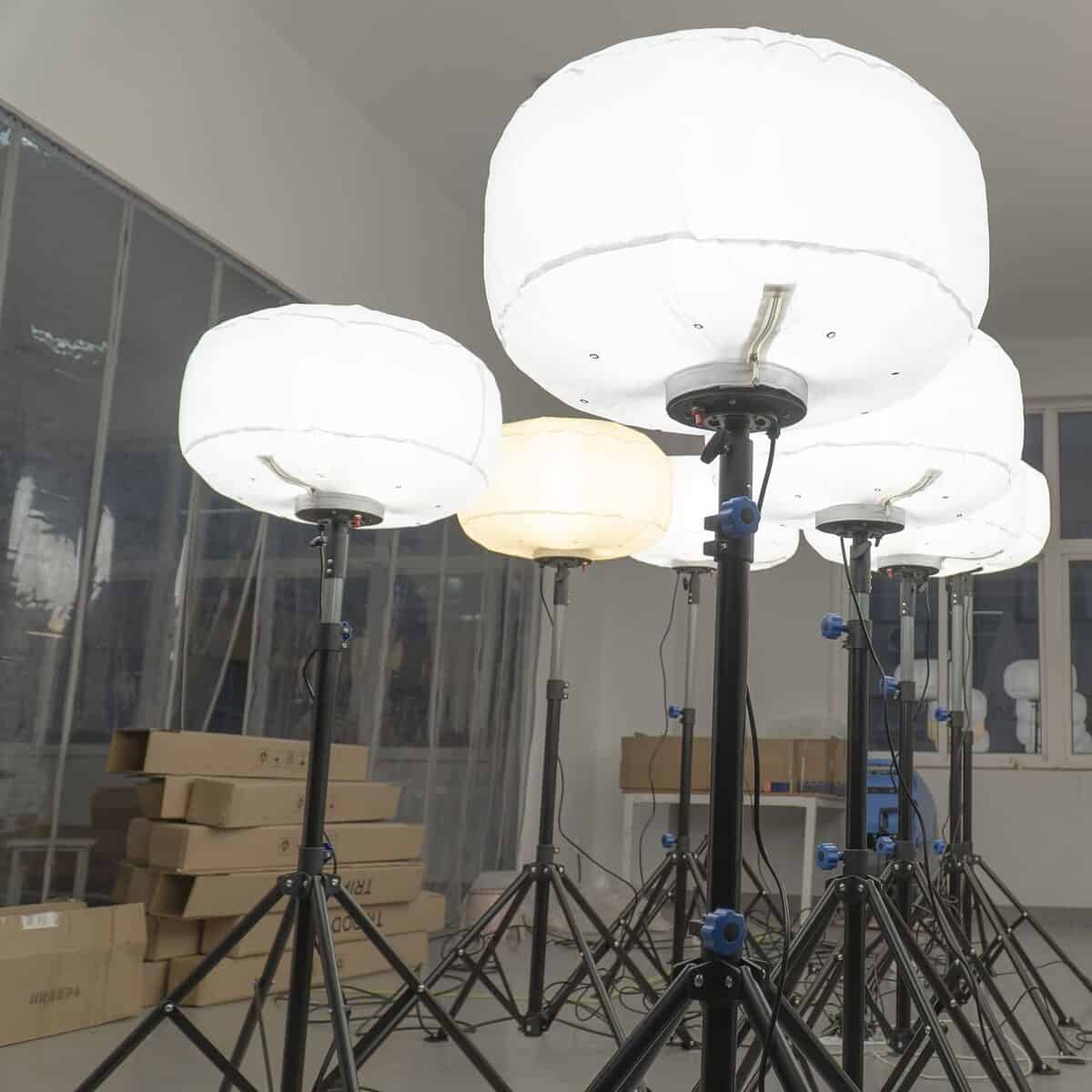
Introduction
Balloon Light Towers are essential tools for illuminating construction sites, events, and outdoor activities. They consist of a high-intensity light source mounted on top of an inflatable balloon that is lifted to an elevated position by a telescoping mast. Balloon Light Towers are portable, easy to set up, and can provide bright, uniform glare free lighting for an extended period, making them an ideal lighting solution for a wide range of applications.
However, like any other lighting equipment, Balloon Light Towers require proper maintenance and care to ensure optimal performance and longevity. Neglecting maintenance and care can lead to premature failure, decreased efficiency, and safety hazards.
Preparing Your Balloon Light Tower for Use
Choosing the right balloon light tower for your construction project is essential to ensure that the job site is well-lit, safe, and productive. Here are some factors to consider before making a purchase:
Inspection and Testing
Before buying a balloon light tower, it's important to check if it has undergone rigorous testing and inspection to ensure that it meets safety standards and can withstand harsh outdoor environments. The manufacturer should have a quality control process in place to guarantee that the product is free of defects and malfunctions. The unit should also be tested to ensure that the lighting is working correctly and illuminating the area with sufficient lighting. For example, a construction company should look for a manufacturer that provides certification of compliance and a comprehensive inspection report for each unit sold.
Cleaning and Maintenance
Cleaning and maintenance are crucial for ensuring that the balloon light tower lasts longer and remains in excellent condition. When selecting a balloon light tower, consider the maintenance requirements and whether the manufacturer provides instructions for cleaning and upkeep. The unit should be easy to clean, and the materials should be durable enough to withstand harsh weather conditions.
Replacing Parts and Accessories
Like any other lighting equipment, balloon light towers may require replacement parts and accessories due to wear and tear or damage to ensure proper lighting. Before buying a light tower, it's important to consider the availability of replacement parts and accessories. The manufacturer should provide a list of parts that may need to be replaced and instructions on how to replace them. The parts should also be readily available and affordable.
Storage and Transportation

Choosing the right balloon light tower for your construction project is important, but it's also crucial to consider how you will store, transport, and protect the unit.
Proper Storage and Handling
When not in use, the balloon light tower should be stored in a safe and secure location to prevent theft, damage, or unauthorized use. There should be a guideline on how to properly store the unit and any necessary precautions to take. For instance, a company may choose to store the light tower in a locked storage room or secure trailer when it's not in use.
Transporting Your Balloon Light Tower
Transportation of the balloon light tower should also be taken into consideration before purchasing. Unlike traditional lighting sources, portable balloon lights may be used for temporary lighting by moving them to various job sites. Consider the size and weight of the unit and whether it can be easily transported to the job site. There should be instructions on how to properly transport the unit to avoid damage.
Protecting Against Damage and Weathering
The balloon light tower may be subjected to harsh weather conditions or accidental damage during use. Before purchasing, consider the durability and strength of the materials used to make the unit, and whether it can withstand harsh weather conditions. You should get instructions on how to protect the unit from damage during use.
Cleaning and Maintenance Tips
When choosing the right balloon light tower for your construction project, there are several important factors to consider. Among these factors are cleaning techniques and products, lubricating and tightening components, as well as checking and replacing filters and belts. Let's dive into these factors in more detail:
Cleaning Techniques and Products

It's important to choose a balloon light tower that is easy to clean and maintain. Consider the materials used in its construction, as well as the type of lights used. For example, LED lights are often more durable and require less maintenance than traditional bulbs. Make sure you have the right cleaning products for the materials used in your portable light towers and follow the manufacturer's instructions for cleaning and maintenance.
Lubricating and Tightening Components
Balloon light towers are typically made up of many different components that must work together to function properly. Over time, components like the lighting fixtures may become loose or require lubrication to operate smoothly. It's important to choose portable light towers that are designed with easy-to-access components and that come with clear instructions for lubricating and tightening them.
Troubleshooting Common Issues
Like any other equipment, balloon light towers may encounter issues that require troubleshooting. Some of the common issues and how to diagnose and fix them include:
Identifying and Diagnosing Problems
- The balloon doesn't inflate or doesn't stay inflated - this could be due to a leak or tear in the balloon material. Check the balloon for punctures or holes and patch them up as needed.
- The lights don't turn on - this could be due to a faulty bulb, wiring, or generator. Check the bulbs for damage and replace them if needed. Inspect the wiring for any signs of damage or lose connections. Make sure the generator is working correctly.
- The balloon wobbles or tilts - this could be due to uneven ground or a malfunctioning stabilizer system. Check the ground for stability and adjust the stabilizer legs as needed.
Basic Repairs and Maintenance
- Keep the balloon clean and free from dirt and debris. Use a soft cloth or sponge to wipe down the balloon surface.
- Regularly inspect the stabilizer legs and ensure they are tight and secure.
- Replace any damaged or worn-out bulbs immediately to ensure even illumination.
- Keep the generator well-maintained and serviced regularly.
When to Seek Professional Help
- If the balloon material is severely damaged or torn, it may need to be replaced entirely.
- If the wiring or generator is significantly damaged, it may be best to seek professional help to avoid further damage or potential hazards.
- If you are unsure of how to diagnose or fix any issues, it may be best to contact a professional technician or the manufacturer for assistance.
Safety Measures and Guidelines

Balloon light towers are an excellent source of illumination for outdoor events and construction sites. However, it is essential to follow safety measures and guidelines to ensure that they are operated safely. Here are some safety measures and guidelines to follow when using LED balloon light towers:
General Safety Precautions
Always read the manufacturer's instructions and guidelines before operating a balloon light tower. Ensure that the tower is set up on the level ground and is stable to prevent it from tipping over. Make sure that the area around the light tower is clear of any obstacles, including power lines, trees, and buildings.
Always wear appropriate personal protective equipment, including gloves and safety glasses, when working with a balloon light tower. Do not climb or stand on the tower or attempt to move it when it is in use.
Electrical Safety and Wiring Guidelines
Before plugging in a balloon light tower, ensure that the power source is suitable for the voltage and amperage of the light tower. Use only grounded electrical outlets and extension cords rated for outdoor use. Inspect the electrical cords and connections for any signs of wear or damage.
Do not attempt to repair or modify the electrical wiring or components of the balloon light tower. If you suspect any electrical problems, contact a qualified electrician or the manufacturer for assistance.
Proper Use and Operation Instructions
Follow the manufacturer's instructions for setting up and operating the balloon light tower. Do not exceed the recommended maximum height for the light tower, as this can affect its stability and safety.
When operating the light tower, ensure that the balloon is properly inflated and secured. Avoid pointing the light directly into the eyes of anyone nearby, as this can cause temporary blindness. Use caution when moving the light tower, as it may be top-heavy and difficult to maneuver.
Compliance with Regulations and Standards

Applicable Regulations and Standards
Balloon light towers are subject to various regulations and standards, depending on their location and use. These may include local and state regulations for outdoor events, construction sites, and temporary structures. There may also be industry-specific standards that apply, such as those from the Occupational Safety and Health Administration (OSHA) or the National Fire Protection Association (NFPA).
It is essential to research and complies with all relevant regulations and standards to ensure the safe and legal use of the balloon light tower.
Certification and Testing Requirements
In addition to complying with regulations and standards, balloon light towers may also require certification and testing. This ensures that the equipment meets specific safety and performance requirements.
Certification may be required by regulatory bodies or industry organizations. Testing may include electrical safety testing, stability testing, and load testing, among others.
Maintaining Documentation and Records
To demonstrate compliance with regulations and standards, it is important to maintain documentation and records. This may include inspection reports, testing results, and certifications.
Keeping accurate and up-to-date records can also help with maintenance and troubleshooting. If issues arise with the balloon light tower, documentation can help identify the source of the problem and determine the appropriate course of action.
Conclusion

In conclusion, choosing the right balloon light tower for your construction project is crucial to ensure that you have adequate lighting for your work site. Factors to consider when selecting portable light towers include the size of your project, the height of the tower, the type of bulb or lamp, the power source, and the overall cost.
It is also essential to consider the quality and durability of the LED balloon lights, as well as their portability and ease of use. By taking the time to evaluate these factors and select the right balloon light tower for your construction project, you can improve visibility and safety on your work site, which can help increase productivity and reduce accidents.
Remember to also follow proper maintenance and safety guidelines for your balloon light tower, as outlined in our other articles, to ensure safe and efficient operation. With the right balloon light tower and proper care, you can keep your construction project well-lit and on track for success.




